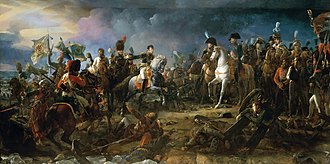Battle of Austerlitz
In the battle of Austerlitz, Napoleon Bonaparte fought Russian and Austrian troops. The battle took place near Austerlitz (now in the Czech Republic) in 1805. Napoleon’s big victory let him create the Confederation of the Rhine. The book War and Peace by Leo Tolstoy contains a detailed description of the battle.
| Battle of Austerlitz | |||||||||
|---|---|---|---|---|---|---|---|---|---|
| Part of the War of the Third Coalition | |||||||||
 Napoléon at the Battle of Austerlitz, by François Gérard (Galerie des Batailles, Versailles) | |||||||||
| |||||||||
| Belligerents | |||||||||
|
| |||||||||
| Commanders and leaders | |||||||||
|
| |||||||||
| Strength | |||||||||
| 65,000–68,000 (not including III Corps)[1] | 84,000–95,000[2] | ||||||||
| Casualties and losses | |||||||||
|
| ||||||||
The battle sometimes (as of the 2020s) gets acted out (or reenacted).[5]
Battle Of Austerlitz Media
Napoleon accepts the surrender of General Mack and the Austrian army at Ulm. Painting by Charles Thévenin
Napoleon with his troops on the eve of battle. Painting by Louis-François, Baron Lejeune
French cuirassiers taking position
Capture of a French regiment's eagle by the cavalry of the Russian guard, by Bogdan Willewalde (1884)
The decisive attacks on the Allied center by St. Hilaire and Vandamme split the Allied army in two and left the French in a golden tactical position to win the battle.
By 1400 hours, the Allied army had been dangerously separated. Napoleon now had the option to strike at one of the wings, and he chose the Allied left since other enemy sectors had already been cleared or were conducting fighting retreats.[source?]
The Battle of Austerlitz, 2 December 1805 by Joseph Swebach-Desfontaines
Interview Between Napoleon and Francis II by Antoine-Jean Gros, 1812. Napoleon and Francis I after the Battle of Austerlitz
References
- ↑ French numbers at the battle vary depending on the account; 65,000, 67,000, 73,000, or 75,000 are other figures often present in the literature. The discrepancy arises because about 7,000 men of Davout's III Corps were not at the battle right when it started. Including or not including these troops is a matter of preference (in this article, they will be included as separate from the 67,000 French soldiers originally on the field). David G. Chandler, The Campaigns of Napoleon. p. 416 gives 67,000 (without Davout's III Corps)
- ↑ Allied numbers at the battle vary depending on the account; 73,000, 84,000, or 89,000 are other figures often present in the literature. Andrew Uffindell, Great Generals of the Napoleonic Wars. p. 25 gives 73,000. David G. Chandler, The Campaigns of Napoleon. p. 417 gives 85,000. In Napoleon and Austerlitz (1997), Scott Bowden writes that the traditional number given for the Allies, 85,000, reflects their theoretical strength, and not the true numbers present on the battlefield.
- ↑ Chandler.
- ↑ Andrew Roberts, Napoleon, A Life. p. 390
- ↑ https://www.nrk.no/urix/kva-kan-vi-eigentleg-laere-av-napoleon_-1.16682825. Retrieved 2024-01-07









